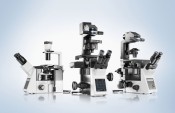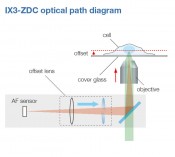New highly expandable platform for live cell imagingA Higher Level of Live Cell ResearchDesigned with the scientist’s workflow in mind the innovative new IX3 series of inverted research microscope systems from Olympus are developed for effortless, intuitive live cell imaging and clinical analysis. Built using worldwide customer feedback and designed to meet the needs of a wide range of users, the new systems offer exceptional ease-of-use and unprecedented optical flexibility via a new, customisable light path. New components can be easily slid into the light path using a series of swappable decks. This opens up many new avenues for exploration, allowing researchers to follow their imaginations. The new IX3 inverted microscope systems (Fig.1) are optimised for live cell imaging. The series also utilise the latest Olympus innovations in frame design, optics and software, providing exceptional stability, optical quality, accuracy and reliability. This includes the fully automated IX83 for high-end research applications, the flexible IX73, which can be configured in manual, semi-motorised or motorised modes, and the easy-to-use IX53 with fluorescent capabilities, which is optimised for the routine examination of tissue samples.
Fig. 1 IX3 Family
Truly ‘Open Access’ In particular, the IX73 and IX83 are built using a new swappable deck design, which allows optical modules to be easily and rapidly slipped in and out as needed, including magnification changer, filter turrets, a right side port and more (Fig.2). This means that the systems are truly ‘open access’ and can be fully customised to meet the requirements of a wide range of applications, even allowing the utilisation of user-designed custom modules to provide the ultimate level of flexibility. This design also allows the systems to grow alongside the evolving demands of the users life science research projects. This is especially true of the IX73, which is highly configurable and capable of integrating with a range of computer-coded or motorised components.
Fig. 2 A diverse range of units is available for the Olympus IX3 microscope system
Intuitive as Standard The IX73 has been designed with an emphasis on ease-of-use and working efficiency. This makes it ideal for a range of routine and advanced research tasks. As it can be manual or semi-motorised and contains an ‚open access’ to the infinite light path, the IX73 can be rapidly modified. The microscope comes as a one-deck system with an ergonomic low stage height, or a two-deck system with additional expansion capabilities. Users can build a uniquely flexible system that enables them to produce expert results with minimal training. This extends from brightfield and phase contrast methods, through to fluorescent imaging. In addition, every image produced is of the highest quality, even during long or complex time lapse experiments, thanks to an improved focus mechanism, which reduces any drift phenomenon to a minimum. Ideal Capturing of Time-Lapse Images With new frame architecture and focus drive design, the IX3 system offers enhanced rigidity that reduces the impact of vibration and heat. It maintains the desired positions along the X, Y and Z axes to allow reliable time-lapse imaging. The real-time Z-drift compensation system capabilities of the IX3-ZDC combined with the Olympus ultrasonic stage is capable of multipoint imaging to capture high-precision multipoint time-lapse images that are never out of focus or misaligned. The IX3-ZDC uses low-phototoxicity IR light to detect the correct focus position as set by the user. One-shot AF mode allows several focus positions to be set, enabling efficient Z-stack acquisition in multi-position experiments. Continuous AF mode keeps the desired plane of observation precisely in focus, avoiding focus drift due to temperature changes or the addition of reagents, making it ideal for measurements such as TIRF that require more stringent focusing (Fig.3). IX3-ZDC focus detection can be performed via the innovative touch panel independent of software (Fig.4).
Fig. 3 X3-ZDC optical path diagram
Fig. 4 ZDC one-shot function detects focus fast, even in high-magnification observation
Clear and Bright Images Olympus UIS2 infinity-corrected optics provide bright, high-resolution images from ultraviolet to near-infrared. The system ensures high optical transmittance with a broad range of objectives providing wide chromatic correction and high resolution, as well as high S/N primary images regardless of the observation method. The wide field of view and fly-eye lens system provide uniform fluorescence images and enable the use of sCMOS cameras with large chips. For a Myriad of Research Needs In particular, the highly-stable and robust IX53 is ideal for continual use in research and clinical laboratory environments, as it is exceptionally easy-to-use and has an ergonomic, low stage. The fully motorised and automated IX83 along with the semi-motorised IX73 are designed to satisfy a myriad of research needs. With additional modules providing expanded functionality, both microscopes provide the ability to enable a multitude of imaging techniques, ranging from long-term time-lapse imaging and other demanding cutting-edge techniques to casual documentation. The systems also integrate seamlessly with the powerful and intuitive Olympus cellSens software*, providing hassle-free imaging and documentation. No matter what the task, the IX3 series delivers the performance and expandability needed to accommodate the demands of tomorrow. * cellSens software is not for clinical diagnostic use. |
L&M int. 1 / 2013
Free download here: download here Read more articles online |














